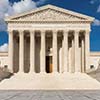California Supreme Court Provides Clarification on Application of Anti-SLAPP Provisions to Claims Involving both Protected and Non-Protected Speech

August 2016
Number 54
Resolving a statewide split in authority, the California Supreme Court has clarified the scope of California's anti-SLAPP provisions (Code Civ. Proc., § 425.16, et seq.), which prohibit efforts to chill free speech and access to the courts, and their application to causes of action arising from protected and unprotected activity, often called "mixed causes of action." In Baral v. Schnitt (August 1, 2016, No. S225090) __ Cal.4th __ <http://www.courts.ca.gov/opinions/documents/S225090.PDF>, the Supreme Court stated unequivocally that any legal claim challenging both protected and unprotected speech, no matter how pled, is subject to a "special motion to strike" as provided by the anti-SLAPP statute.
California's anti-SLAPP law protects a person's rights of petition and free speech in connection with public issues by subjecting lawsuits based on any of the "protected" activities listed therein to a special motion to strike, which may eliminate the claims early in the litigation process. Complaints based on these types of activities are prohibited as they are considered "strategic lawsuits against public participation," or "SLAPPs," designed to chill the exercise of certain rights, including free speech rights and right of access to the courts. An anti-SLAPP motion may only be overcome if the plaintiff defending it is able to demonstrate a probability of succeeding with their claim. If a defendant makes a successful anti-SLAPP motion, then the portions of the complaint successfully challenged by the motion are thrown out and he or she is entitled to reasonable attorney's fees.
The Supreme Court's ruling brings much-needed clarity to what until now has been a murky situation fueled by conflicting opinions from the state's courts of appeal and eliminated an oft-used end-run around the statute. Prior to the ruling, litigants would "plead around" an anti-SLAPP motion by basing causes of action in a complaint on a mix of protected and unprotected speech. This tactical maneuver is now clearly ineffective in avoiding an anti-SLAPP motion. The ruling may also reduce lawsuits partially based on free speech, petitioning activity and other "protected activity" included in California's anti-SLAPP statute - especially considering that the party on the losing end of an anti-SLAPP motion is responsible for the other party's attorney fees.
In Baral, two former business partners were embroiled in litigation over the sale of their company. One of the partners filed a complaint against the other, alleging among other things that the other partner intentionally prevented him from participating in an audit designed to value the company in anticipation of the sale. In response to the complaint, the second business partner filed an anti-SLAPP motion, claiming that the audit was protected speech. The trial court denied the motion, ruling that the state's anti-SLAPP law did not apply because the causes of action listed in the lawsuit were based on both protected and unprotected speech; in other words, the causes of action were "mixed." The Court of Appeal agreed, relying on earlier case law that said that a cause of action alleging both protected and unprotected speech is not subject to the special motion to strike.
The Supreme Court overturned the Court of Appeal's decision. In doing so, it recognized that California's appeals courts offered differing opinions regarding mixed causes of action and whether they were subject to the protections of the anti-SLAPP statutes. The Supreme Court said that since the state's anti-SLAPP law is designed to protect a defendant's conduct "from the undue burden of frivolous litigation," its protections should not be foreclosed based on the way a complaint is framed.
For further information on this case or California's anti-SLAPP law, please contact the authors of this Client News Brief or an attorney at one of our nine offices located statewide. You can also visit our website, follow us on Facebook or Twitter or download our Client News Brief App.
Number 54
Resolving a statewide split in authority, the California Supreme Court has clarified the scope of California's anti-SLAPP provisions (Code Civ. Proc., § 425.16, et seq.), which prohibit efforts to chill free speech and access to the courts, and their application to causes of action arising from protected and unprotected activity, often called "mixed causes of action." In Baral v. Schnitt (August 1, 2016, No. S225090) __ Cal.4th __ <http://www.courts.ca.gov/opinions/documents/S225090.PDF>, the Supreme Court stated unequivocally that any legal claim challenging both protected and unprotected speech, no matter how pled, is subject to a "special motion to strike" as provided by the anti-SLAPP statute.
California's anti-SLAPP law protects a person's rights of petition and free speech in connection with public issues by subjecting lawsuits based on any of the "protected" activities listed therein to a special motion to strike, which may eliminate the claims early in the litigation process. Complaints based on these types of activities are prohibited as they are considered "strategic lawsuits against public participation," or "SLAPPs," designed to chill the exercise of certain rights, including free speech rights and right of access to the courts. An anti-SLAPP motion may only be overcome if the plaintiff defending it is able to demonstrate a probability of succeeding with their claim. If a defendant makes a successful anti-SLAPP motion, then the portions of the complaint successfully challenged by the motion are thrown out and he or she is entitled to reasonable attorney's fees.
The Supreme Court's ruling brings much-needed clarity to what until now has been a murky situation fueled by conflicting opinions from the state's courts of appeal and eliminated an oft-used end-run around the statute. Prior to the ruling, litigants would "plead around" an anti-SLAPP motion by basing causes of action in a complaint on a mix of protected and unprotected speech. This tactical maneuver is now clearly ineffective in avoiding an anti-SLAPP motion. The ruling may also reduce lawsuits partially based on free speech, petitioning activity and other "protected activity" included in California's anti-SLAPP statute - especially considering that the party on the losing end of an anti-SLAPP motion is responsible for the other party's attorney fees.
In Baral, two former business partners were embroiled in litigation over the sale of their company. One of the partners filed a complaint against the other, alleging among other things that the other partner intentionally prevented him from participating in an audit designed to value the company in anticipation of the sale. In response to the complaint, the second business partner filed an anti-SLAPP motion, claiming that the audit was protected speech. The trial court denied the motion, ruling that the state's anti-SLAPP law did not apply because the causes of action listed in the lawsuit were based on both protected and unprotected speech; in other words, the causes of action were "mixed." The Court of Appeal agreed, relying on earlier case law that said that a cause of action alleging both protected and unprotected speech is not subject to the special motion to strike.
The Supreme Court overturned the Court of Appeal's decision. In doing so, it recognized that California's appeals courts offered differing opinions regarding mixed causes of action and whether they were subject to the protections of the anti-SLAPP statutes. The Supreme Court said that since the state's anti-SLAPP law is designed to protect a defendant's conduct "from the undue burden of frivolous litigation," its protections should not be foreclosed based on the way a complaint is framed.
For further information on this case or California's anti-SLAPP law, please contact the authors of this Client News Brief or an attorney at one of our nine offices located statewide. You can also visit our website, follow us on Facebook or Twitter or download our Client News Brief App.
As the information contained herein is necessarily general, its application to a particular set of facts and circumstances may vary. For this reason, this News Brief does not constitute legal advice. We recommend that you consult with your counsel prior to acting on the information contained herein.





